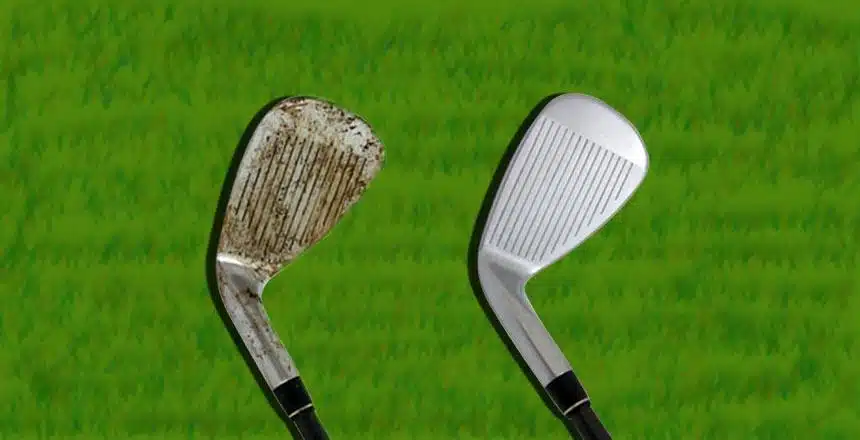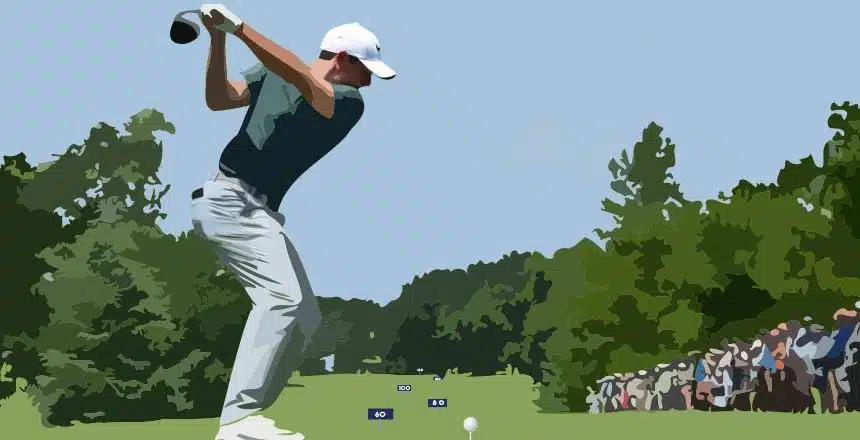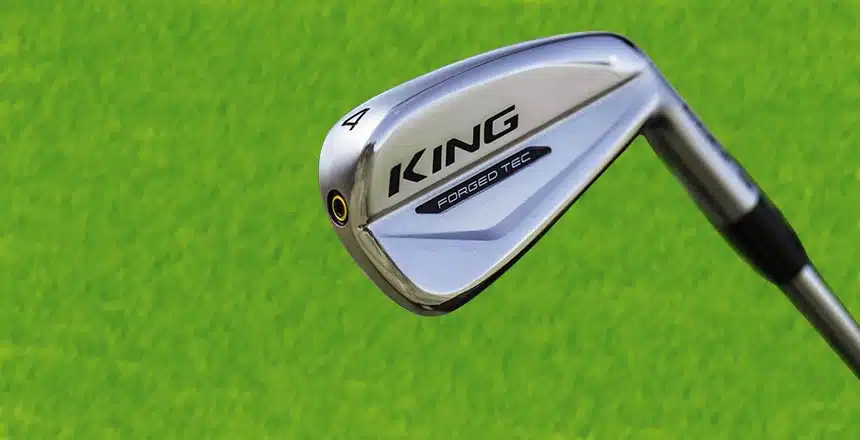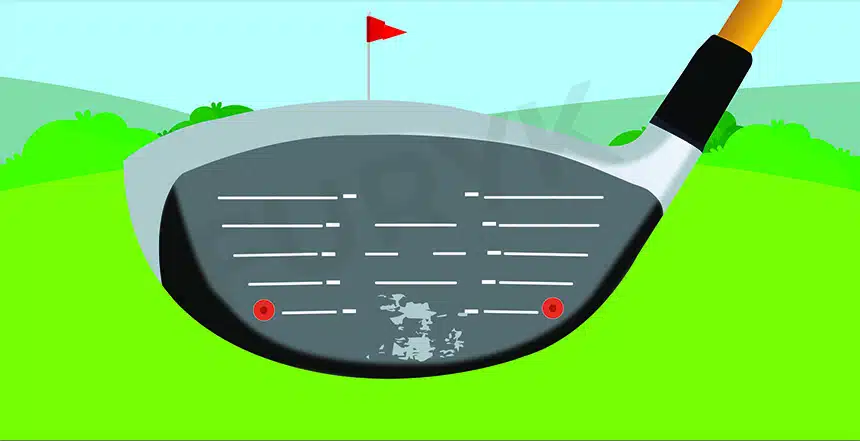Imagine your golf bag filled with irons, wedges, and all or most of your precious golf clubs caked with mud, dirt, grime, etc. With golf balls, you can easily clean them because they’re so tiny but then the same cannot be said about clubs, right? They’re a bigger nightmare to clean, let’s agree on that.
But one thing you should understand is that your swing speed and just your overall golfing skills, no matter how experienced you are, can only do SO MUCH. Meaning the condition of equipment also matters when it comes to playing golf like a pro. Better be hitting woods and irons that are sparkling clean instead of looking old and mud-caked!
So let’s be wise and learn how to get this “tedious” job done right.
In This Post
How to Clean Your Golf Clubs (Woods, Irons, Wedges, & Everything)
First off, what do you need for cleaning: Preparation
- Dish soap
- Soft brush
- Plastic bucket (filled with warm water)
- Scouring pad
- Clean, dry towel
- Tee
Do not wash your golf clubs in the sink as this may lead to scratches or more serious damage.
How to Clean Golf Irons and Wedges
Step 1 – Soak the Irons & Wedges in Dish Soap Water Mixture
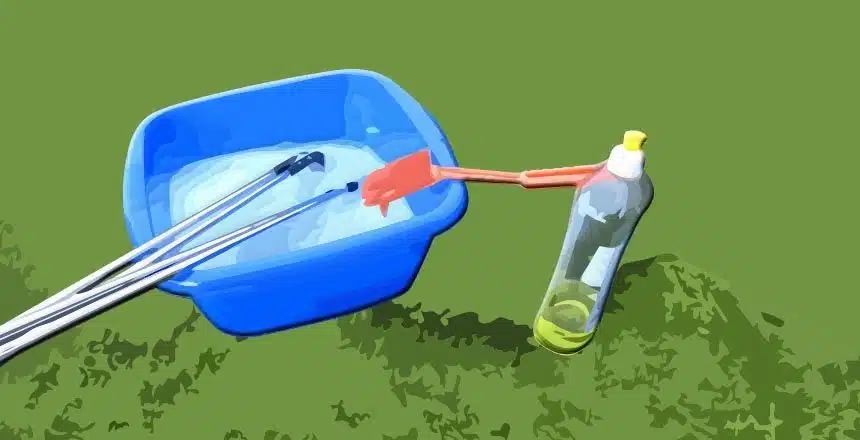
Soaking your golf clubs in that warm soapy water really helps in loosening the dirt stuck to them.
How deep should the water level be? Enough to just submerge clubheads, but not beyond the hosel. Warm water, when it comes in contact with whatever’s past that hosel, seeps within and creates rust spots, eventually damaging the shaft. And you obviously don’t want the heads to detach from their shafts to go flying off uncontrollably and harm something or someone.
Step 2 – Clean and Inspect the Grooves
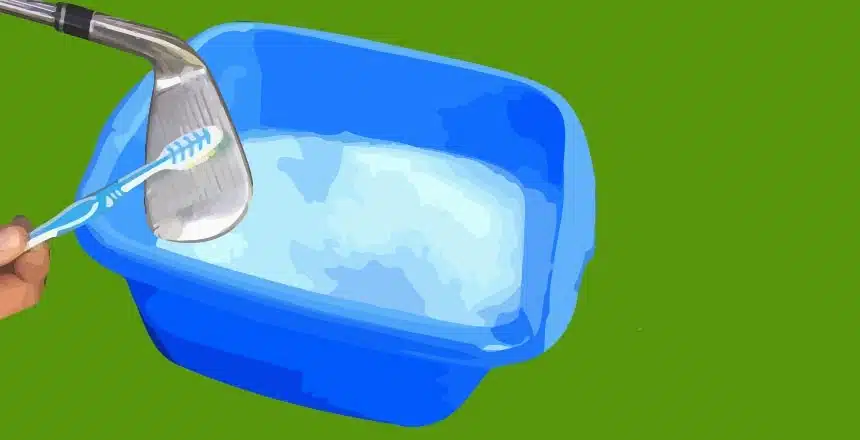
Grooves in golf irons/wedges need the most amount of attention. Because it’s these very grooves that produce friction at the time of contact with the ball. And this friction generates spin, a consistent ball flight, and, ultimately, the distance you’re aiming for.
So don’t forget to clean the grooves with the help of the brush and scouring pad (and soapy water of course). Just scrub gently for getting rid of the dirt.
Are the grooves clean now? In the end, inspect carefully. And if there’s still some stubborn dirt left, use the tee for removing that.
Step 3 – Clean and Inspect the Grips
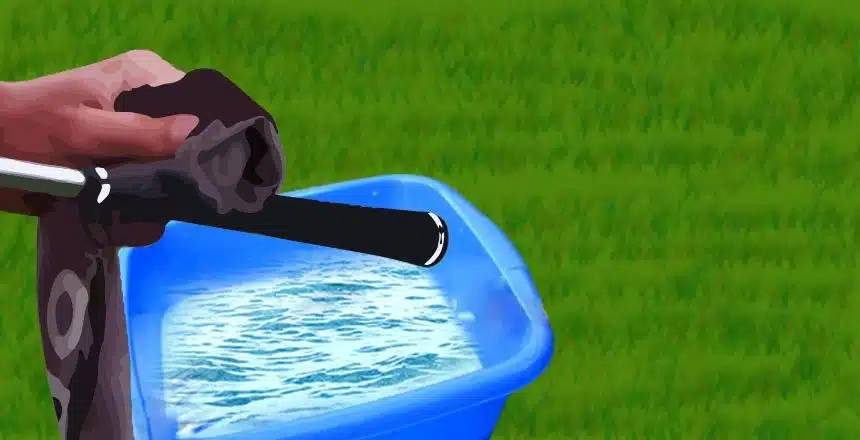
Your point of contact with your golf irons or any other club is the grip. So that better be right. And by right, I mean two things. One is that you should know how to properly grip the iron. And the second is making sure the grip is clean.
For cleaning, use the brush or scouring pad with soapy water for scrubbing off unwanted particles. And, at this point, please remember that grips these days are made to be “tacky” with special coating because it contributes to gripping the club more easily (meaning no more tight grip or over gripping).
What I’m trying to say is that using scouring pads, soap, or any other abrasive tool or material might damage that special coating. That’s why golf club manufacturers recommend just brushing with soap water.
Step 4 – Dry the Irons/Wedges
After washing, dry off the grip, shaft, and head with the help of a clean, dry towel.
Additional Tip:
You can use suitable wood or metal polish for making your golf clubs shine like they’re brand new. Or cleaning golf clubs with WD40 is also an option. Use this golf club cleaner spray on them in case they make visible signs of rusting (more on this later), which happens mostly with forged-type clubs.
How to Clean Golf Driver, Fairway Wood, Hybrid, and Putter
The method of cleaning/washing woods and putters is not the same as with wedges and irons. You don’t need to submerge the former in a warm soapy water mixture, rather just dip and then wipe down using a cloth. And after that, don’t forget to thoroughly dry off the clubheads.
You don’t soak these types of golf clubs because soap, due to its abrasive properties, tends to diminish the shimmer and shine of the original paint and overall condition of the club. So if you use stiff brushes or wires for cleaning, they may form scratches. Instead, gently wash or scrub with the help of a soft-foam brush.
How to Clean Golf Club Grip
Grips have traction, and this traction is susceptible to wearing off due to sweat, sunscreen, and things like that present on your palms. So how about cleaning those old grips to resuscitate them?
The best way to go about is by using a clean, damp cloth or towel to wipe the grips clean. It works very effectively to get rid of surface grime and dirt the most quickly.
But for more meticulous cleaning, here’s what to do.
Step 1 – Prepare the Soap Water
Fill some warm water in a bucket and add a little bit of dish soap or any other cleaning/washing liquid in it for creating soap suds.
Dip a cloth or towel in this soapy water mixture.
Step 2 – Gently Scrub the Grip
Using the wet towel, very lightly scrub away all dirt, mud, and other unwanted particles from the golf club grip.
Step 3 – Rinse the Grip
After scrubbing, rinse the grip under a flow of clean, warm water. Avoid using water that’s too hot unless you intentionally wish to loosen the glue of the grip.
Step 4 – Dry off the Grip
Now with a clean, dry towel, wipe the grip to dry it off. And if there’s any water on the shaft, wipe that down as well (otherwise, rust is most likely to develop).
See this video from Golf Pride Grips
How to Clean Golf Club Shaft
Cracks, nicks, and dents on the shaft can be cleaned off and should be cleaned off actually once in a while. If you maintain your golf clubs’ shafts like this, they’re sure going to last for a much longer time than expected.
But then shafts are the most likely to get damaged because you’re always moving them from one place to another (course to home, home to course, and repeat). At such times, the most you can do is to avoid roughing them up. So don’t slam your golf clubs, don’t lean on your golf clubs, or exert any amount of unnecessary pressure or strain on their shafts.
In the case of steel shafts, maintaining these is easy since they’re more durable than lightweight graphite shafts mostly found on beginner-friendly golf clubs. With steel, you can simply just wipe them off using a damp towel.
As for rust, remove rust spots with steel wool (find-grade, most preferably 0000 or 000 to keep the shaft from getting scratched). You could also apply some car wax or chrome polish post-cleaning just for some extra care (not really mandatory).
Moving on to graphite shafts, they do need special attention. With these types of shafts, there’s a coating of paint and then another one of polyurethane. Both of which are likely to get scratched away, thus exposing and then eventually damaging the graphite material itself.
In that case, turn to headcovers, long-necked types, for protection from serious scratches. However, keeping the shafts clean is indeed a better approach. So use a soft towel or cloth with water to tidy up graphite shafts and then wipe them dry after that. Lastly, coat the whole thing with some good furniture wax.
Best Way to Clean Golf Clubs – What Pros Do!
Here are 4 quick cleaning methods adopted by pros in golf…
- Use a towel, half dry and half wet with warm water, for cleaning every golf club in the bag. Use the wet half for wiping/scrubbing and the other half for drying them up.
- Let a power washer be your companion here – fire it up and then with the help of your hands or legs, hold every clubface in place to get it repeatedly blasted by pressurized water.
- Just use a groove sharpener, divot tool, or simply a tee to dig away mud, dirt, etc. from the grooves of the clubface.
- Soak your golf clubs in a bucket full of warm, soapy water. Next, using a soft cleaning brush and half-wet towel, scrub off the layer of dirt and debris.
First soak, then wipe with the wet end of the towel, and then dunk the clubs into the water again, take them out, and brush away. And in the end, wipe it all dry using the dry part of the towel.
How to Clean Golf Clubs Rust
Golf clubs are rusty? If yes, then you need not panic. Simply just read through this section to find out how to clean off rust spots.
A little bit of steel wool, already mentioned once earlier in this post, can and does get rid of light surface rust. Just gently scrub the rust-infested areas with steel wool. But when dealing with deep-seated rusting, try different methods.
Many golfers use a mixture of lemon juice and vinegar for tackling stubborn rust. Cleaning golf clubs with vinegar requires soaking the clubheads in this acidic solution for 1-2 hours, which does the trick. After that, use a brush or cloth for scrubbing off the loosened rust. Some even use Coca-Cola (yes, the American drink!), can you believe it?
Coca-Cola contains phosphoric acid, which is great for effective cleaning. Cleaning golf clubs with Coke – soak your golf clubs in a few liters of Coca-Cola for around 24 hours. Then, with the help of a gentle scrubber, get rid of any leftover rust and wipe those clubheads dry using a microfiber towel or cloth.
Obviously, you can also just use a simple mixture of dish soap and warm water with a brush (already discussed at length above) to eliminate mud, dirt, rust, and the like from the grooves of the clubs.
And lastly, you also get rust removers. But these are often formulated with harsh chemicals, which might damage metal when not used properly. So please go through the instructions provided by the manufacturer.
How to Prevent Rusting of Golf Clubs
Prevention – that’s the very first step toward solving any problem, wouldn’t you agree? So let’s find out how you can actually prevent rust spots from ruining your expensive, most cherished golf clubs. And here’s how…
- After every round, check your clubs properly once you get back home. If there’s any mud, moisture, dirt, etc. on them, clean it off immediately and let the golf clubs dry completely.
- Why wait for your round of golf to end, instead why don’t you just wipe down the club after you use it. Meaning take your shot and then clean using a towel.
Obviously, on a sunny day, this isn’t necessary but when the weather’s rainy or damp, you may want to get rid of moisture rather quickly, thus preventing the formation of rust.
- But what if you don’t play golf all that often? Even then, you should make it a point to keep checking your golf clubs every now and then. Make sure they’re not damp. And if they are, wipe them dry and change where and how you store them.
How to Store Golf Clubs – Care for Them, They Deserve It!
I’m not referring to properly storing golf clubs in a bag when on the course. As long as you have a solidly-built, well-compartmentalized golf bag, such as these designed by top brand TaylorMade, you don’t have to worry about that aspect. Instead, what I’m talking about is this – how to store golf clubs in an apartment, garage, etc.
In terms of caring for them properly, always inspect your clubs closely – grips, shafts, grooves, clubheads, etc. – for lack of shine, cracks, dents, splits, nicks, and other signs of wear and tear. So don’t overlook those grips, for example. Also, shafts, for the most part, last for a very, very long time unless knocked about.
And when in poor, un-mendable condition, the equipment has got to be replaced. Otherwise, performance and progress are hindered.
Now how about long-term and short-term storage? In both scenarios, the settings should be temperature-controlled (not extremely hot) and dry (no humidity). First of all, clean and then dry your golf clubs before placing them inside the bag. Likewise, the inside of the bag should also be dry.
Here’s something that doesn’t get said enough – DO NOT store or even keep your golf clubs set in the trunk or boot of the car, no matter the time. In there, the chances of your clubs getting damaged for some reason or the other (often because they’re jostled around or due to the warmer temperature inside) are higher. And this only leads to the clubs’ epoxy breaking down, hence rendering them useless.
Garages and basements, thus, are the most suitable places for storing your golf clubs.
Frequently Asked Questions
Is Using A Wire Brush Bad for Cleaning Golf Clubs?
A wire brush, no doubt, especially the one you can buy from golf supply stores, is very effective when it comes to digging out dirt from the grooves. Plus, it’s safe to use, so no chances of causing scratches or anything of the sort on the clubface.
Can You Use Magic Eraser to Clean Golf Clubs?
To get rid of scuff marks, a magic eraser definitely helps. Rub off those unwanted scuff marks using the eraser – it’s both quick and effective!
Can You Use Steel Wool to Clean Golf Clubs?
You can indeed clean rust off your golf clubs with the help of steel wool. Just wet the steel wool soap pads and gently rub them against the mucky, rusty areas of the club to make them shine like brand new. Just avoid scrubbing too hard or too much.
Can You Use WD40 to Clean Golf Clubs?
WD40 works like magic for removing rust on golf clubs, so they can really shine like brand new. But then avoid using this common household solution on a club that features a special coating or finish. Likewise, don’t use it to clean wedges and irons.
But whenever you do use it on your other clubs, spray just a little bit on the head and then wipe it down quickly with a towel or cloth. No need to let it sit for too long a time. And no need to scrub either because WD40 does enough scrubbing on its own.
And one more thing, first you have to clean your golf clubs using dish soap and warm water to get rid of all dirt, sand, dust, etc. and then spray on WD40.
Can You Buff Out Scratches On Golf Clubs?
You cannot avoid all scratches and nicks on your golf clubs since any dirt, grit, or sand getting between the club and ball inevitably forms a scratch. However, what you can do is regular inspection and cleaning to prevent any serious or long-term damage. That said, buffing out golf clubs, in that case, is necessary, harmless, and easy.
Light scratches you can buff out quickly using a cleaner that’s non-abrasive. Mix it with some water to create a paste. Then apply the paste to a clean, damp cloth or towel and gently rub off the scratch (follow the grain). The end result – fresh, shiny golf clubs!
How to Polish Golf Clubs On Your Own?
What you’ll be needing:
- A bucketful of warm water
- Dish soap
- A small, soft brush (a toothbrush will also work)
- Towel/cloth (a few at hand)
- Polishing cloth
- And quality car or metal polish!
Instructions:
- You start by cleaning your golf clubs first in a mixture of warm water and dish soap. Soak them in this solution to loosen mud, dirt, etc. And then scrub them gently with a brush (soak this too in the soapy water) till they start to look clean.
- Before moving on to the next step, dry them off properly using a towel as that would make polishing easier.
- And now’s the time to polish the golf clubs with the polishing solution (polishing spray also works by the way) and the soft polishing cloth you have at your disposal.
- Allow the polish to rest on the club for about a minute or so and then wipe it off using a different, clean cloth. And that’s about it!
The EndNote
Getting rust spots, scuff marks, and mud caked on golf clubs is quite a common occurrence. But then getting rid of these wear and tear signs is just as important. Ingredients like steel wool, lemon juice and vinegar mixture, WD40, and even Coca-Cola can be used very effectively, apart from the basic clean-up using dish soap, warm water, and a soft brush.
Proper cleaning is essential, no doubt about that. And once you learn how to tidy up your golf clubs, they’re surely going to last for a much, much longer time. Let’s not also forget that sparkling clean clubs also look very professional and help you perform to the best of your abilities and even their own advanced technologies.
At the same time, storage also matters. Handle them with care and store them away from extreme heat and humidity.

